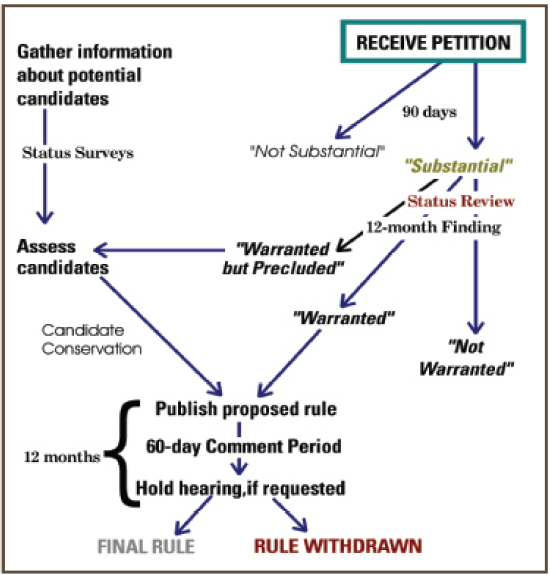
Listen to the audio article of this post.
This is the first installment of a three-part series detailing the listing process under the Endangered Species Act for the monarch butterfly.
In December 2024, the U.S. Fish and Wildlife Service (USFWS) is expected to publish a 12-month finding on the listing status of the monarch butterfly under the Endangered Species Act (ESA). If the monarch still warrants listing, this finding would include a rule proposing to list the species as either endangered or threatened, and would include opening a public comment period. It’s important to understand the decision process and any potential implications a listing may have for farmers and other landowners. In this series of blog posts, Farmers for Monarchs will describe the Endangered Species Act listing process in general and as it pertains to monarchs. We will also explain the considerations USFWS may include when developing possible regulatory decisions and describe the process that allows for public input to help shape any considered regulations, including any rules that could impact farmers and their operations.
The process for determining whether a species warrants listing as endangered or threatened under the ESA in the United States involves several steps. The chart below gives a visual overview of the entire process.

Below are the steps taken during the listing determination review process:
- Petition: The process usually begins with a petition from the public or a government agency to USFWS or the National Oceanic and Atmospheric Administration (NOAA) Fisheries, who share the responsibility for implementing the ESA. USFWS administers the ESA for terrestrial and freshwater species, while NOAA Fisheries administers for marine and anadromous species. The petition provides scientific and commercial data to support the claim that a species should be listed.
- Service Review: Upon receiving a petition, the USFWS conducts an initial review to determine if the petition presents substantial information indicating that listing may be warranted. The agency must make a finding within 90 days of receiving a petition. If USFWS determines there is substantial information indicating listing may be warranted, the agency initiates a more comprehensive status review.
- Status Review: Following the service review, USFWS completes a 12-month status review of the species, including its population size, habitat, threats, and conservation efforts. The status review involves gathering and analyzing scientific data and information from experts, stakeholders, and the public. Status reviews also undergo independent peer review. As outlined in the Endangered Species Act, these factors are from the law itself in section 4(a)(1). If any one of the following five factors is deemed to threaten the existence of a species, the agency is required by law to take action:
- damage to, or destruction of, a species’ habitat;
- overutilization of the species for commercial, recreational, scientific, or educational purposes;
- disease or predation;
- inadequacy of existing protection; and
- other natural or manmade factors that affect the continued existence of the species.
Once the petition and review are completed, USFWS will make a decision as to whether the listing of the species is warranted, not warranted, or warranted but precluded. A status review was completed for the monarch butterfly in 2020, which we detail below, and we will detail the next steps in the process in a later blog post.
Background on the Monarch Butterfly Listing Process
The monarch’s journey as it relates to the listing process began back in August of 2014 when a petition was submitted to the USFWS by the Xerces Society for Invertebrate Conservation, the Center for Biological Diversity, Center for Food Safety, and the late Dr. Lincoln Brower. This petition aimed to address the declining population of monarch butterflies, particularly those that migrate annually from Mexico through the U.S. Southern and Midwestern states into Canada. After several legal actions and extensions, the USFWS announced in December 2020 that listing the monarch butterfly was warranted but precluded by higher priority listing actions. This means that the monarch butterfly was added to the candidate species list and was assigned a listing priority number of eight. This priority number indicated the magnitude of threats to the monarch is moderate and those threats are imminent. As such, the monarch’s status has been reviewed each year since this announcement.
Another Decision Coming December 2024
In March, USFWS issued a statement that the agency is working on the latest status assessment for monarch butterfly and, if still warranted, is planning to submit a proposed rule to the Federal Register by December 4, 2024. This decision could have an impact on farmers and landowners; however, we won’t know if the monarch will be proposed for listing and how a proposed rule would impact farmers and landowners until December.
When a species is proposed for listing as endangered or threatened under the Endangered Species Act, USFWS may also identify specific areas that are essential to its conservation. These areas are the species’ critical habitat. Critical habitat designations do not affect activities by private landowners if there is no federal funding or permits required to carry out the activity.
In our next post in this series, we will clarify the differences between a species being classified as threatened or endangered and how that guides regulatory actions. We will also delve deeper into any potential designation of critical habitat and its implications for farmers, landowners, and general conservation efforts. Additionally, we will provide an overview of the 4(d) rule, a flexible regulatory mechanism designed to tailor protections for threatened species while accommodating economic and social activities.
